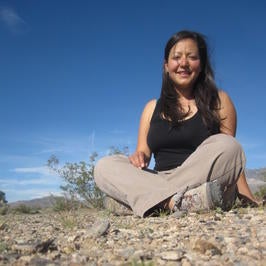
Alejandra Martínez-Berdeja
Background
I became interested in plant ecology while studying Biology at Universidad Nacional Autónoma de México in Mexico City. My thesis on cacti ecophysiology introduced me into the fascinating adaptations of desert plants to extreme environments. Currently, I am a PhD candidate working under Dr. Exequiel Ezcurra at the Botany and Plant Sciences Department at the University of California, Riverside, conducting research on desert serotinous (seed retaining) species to understand the adaptations of desert plants to unpredictable and variable environments.
My work is also concerned with the ways that science impacts law and society. My undergraduate thesis in Law at the Instituto Tecnológico Autónomo de México analyzed the role of Mexico's Human Rights Commission in promoting the right to a sound environment through its public participation mechanism. As an ecologist, I aim to continue exploring the means by which science can inform environmental policy.
My full Curriculum Vitae can be found here.
Research
I study the adaptations of desert plants to both highly variable rainfall events and environmental cues occurring at different time and spatial scales. My dissertation focuses on the ecological and evolutionary significance of seed retention and delayed seed dispersal as a strategy to cope with dry and unpredictable conditions. I am currently working with Chorizanthe rigida (Polygonaceae), a winter desert annual distributed in the Mojave and Sonoran deserts that retains its seeds in its hard, spiny involucres (dispersal units), and releases them with incoming rains.
In particular, I explored the following research questions: 1. What is the effect of C. rigida's delayed seed disperal on its distribution on desert pavements? 2. Are C. rigida populationslocally adapted to regions with differing seasonal cues and rainfall variability patterns? 3. What is the biomechanical effect of C. rigida involucre morphology on the timing of seed dispersal?
Publications
Martínez-Berdeja, A., and T. Valverde. 2008. Growth response of three globose cacti to radiation and soil moisture: An experimental test of the mechanism behind the nurse effect. Journal of Arid Environments 72: 1766 – 1774.
Martínez-Berdeja, A., Pietrasiak, N., Tamase, A., Ezcurra, E. and Allen, E.B. 2013. Living where others dare not: Microhabitat distribution in Chorizanthe rigida, a serotinous desert annual. Journal of Arid Environments 97: 120 – 126.
Holt, J. S., Welles, S. R., Silvera, K., Heap, I. M., Heredia, S. M., Martínez-Berdeja, A., Palenscar, K. T., Sweet, L. C., and Ellstrand, N. 2013. Taxonomic and life history bias in herbicide resistant weeds: implications for deployment of resistant crops. PLoS ONE8(9):e71976.
Martínez-Berdeja, A., Torres, M., Altshuler, D. L. and Ezcurra, E. 2014. Hydration history and attachment morphology regulate seed release in Chorizanthe rigida (Polygonaceae), a serotinous desert annual. American Journal of Botany 101(7):doi 10.3732/ajb.1400120
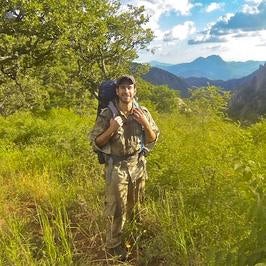
Dr. Benjamin T. Wilder
Associated Researcher | Ezcurra Lab, UC Riverside
Visiting Researcher | Dirzo Lab, Stanford University
Visiting Researcher | Baldwin Lab, UC Berkeley

My research is broadly focused in desert ecology and botany. I utilize multiple approaches and time scales to establish baselines to better understand modern biodiversity and connect science to conservation.
I increasingly value the incorporation of diverse perspectives and the powerful results made possible via collaboration. In my role as director of the Next Generation Sonoran Desert Researchers (N-Gen) I strive to create opportunities for collaboration across borders and disciplines and a more holistic understanding and appreciation for the Sonoran Desert.
My current research and efforts focus on the following themes:
- Understanding the origin of the Sonoran Desert and the arid lands of the New World through historical biogeography. I specifically employ phylogeography, paleoecology (fossil packrat midden analysis), floristics, ancient DNA, and additional techniques.
- Develop a scientific approach to change the paradigm of conservation vs. development towards science guiding future change. Collaborative efforts are currently focused in the region of Cabo Pulmo in Baja California Sur where we are developing a Land:Sea Planning Map to connect science to future land use planning and link the often overlooked interface of the land and sea.
- Lead conservation ecology courses among the Comcaac (Seri people) to provide the highest level of scientific and conservation education in support of the next generation of indigenous leaders.
CV
To see my resumé follow this link.
Publications
Felger, R.S. & B.T. Wilder in collaboration with H. Romero-Morales. 2012. Plant Life of a Desert Archipelago: Flora of theSonoran Islands in the Gulf of California. University of Arizona Press, Tucson. 624 pages.

Available for purchase at: UofA Press and Amazon
1. Wilder, B.T. 2007. Report to Arizona-Nevada Academy of Science on the project: Vascular flora of Isla Tiburón and Satellite Islands, Gulf of California Mexico. Journal of the Arizona-Nevada Academy of Science 39(1): 51–55.
In Progress
Wilder, B.T., E. Ezcurra, R.S. Felger. In Prep. Revisiting Island Biogeography in the Gulf of California.
Wilder, B.T., F. Molina-Freaner, E. Ezcurra. In Prep. Tracking the Desert's Edge with a Pleistocene Relict.
Dolby, G. Bennett, S. E. K., A. Lira-Noriega, B. T. Wilder, A. Munguia-Vega. In Revision. The Geologic and Climatic Forcing of Biodiversity Surrounding the Gulf of California. In, Wilder, B.T., C. O'Meara, N. N. Narchi et al. (eds.) Seeds in the Sand: Emerging approaches to Understanding the Sonoran Desert and Gulf of California. Journal of the Southwest.
Wilder, B.T., C, O'Meara, N. N. Narchi, R. F. Rentería-Valencia, S. Vanderplank, J. Torre. In Prep. Seeds in the Sand: Emerging approaches to Understanding the Sonoran Desert and Gulf of California. Journal of the Southwest.
Van Devender, T., R. S. Felger, J. Sanchéz-Escalante, B. T. Wilder. In Prep. Flora of the Municipio de Hermosillo, Sonora, Mexico.
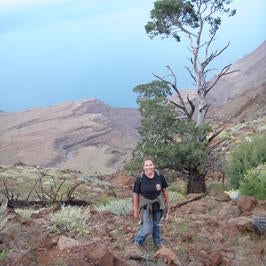
Sula Vanderplank
Current Research
My current research is focused around the macroecology of Baja California, with an emphasis on plant distributions along the Pacific coast of the state of Baja California and the adjacent islands, where the California Floristic Province meets the Vizcaino desert to the south. My interests center on range limits, endemism, and changes in the biogeography, phenology and phylogenetic affinities of the plants in the ecotone. In addition to my dissertation research on the plants of this region I have several active collaborative projects in Baja California.
My resume is available here.
Collaborative projects:
As Science Advisor for Terra Peninsular (http://terrapeninsular.org/) I am fortunate to be involved in several projects relating to conservation in NW Baja California, with particular regard to the conservation of the Maritime Succulent Scrub, an endangered habitat found nowhere else in the world.
Working with staff from Huntington Botanical Gardens and Club La Mision, a project to produce a guide to the 'Quail-Friendly Plants of North-West Baja California’ [click here to download a low-res version] recently culminated in a field-guide to more than 120 plant species in this region. This project has also allowed us to install six weather stations between Ensenada and San Quintín, monitoring variation accross this strong rainfall gradient.
Working closely with Sergio Mata, and in collaboration with Carlos Figueroa we are studying the unique plants that grow on shell middens left behind by the indigenous peoples of the region. My master’s research suggests that the flora of these middens is distinct from the surrounding areas and habitats and warrants further research.
I am fortunate to be part of a project to assemble an inventory of all the rare and endemic plants of the California Floristic Province portion of Baja California (the north-west area of the state). Collaborators in this project include Bart O’Brien (Rancho Santa Ana Botanic Garden), Jose Delgadillo (Universidad Autónoma de Baja California), Steve Junak (Santa Barbara Botanic Garden), Tom Oberbauer (San Diego County Planning Jon Rebman (San Diego Natural History Museum), and Hugo Riemann (Colegio de la Fronterra).
Publications
Vanderplank, S. E. 2011. The Flora of Greater San Quintín, Baja California, Mexico. Aliso 29: 65–106
Vanderplank, S. & J. Delgadillo-Rodriguez. 2008. Documentando la Flora Vascular de San Quintín y Áreas Adyacentes (Baja California). IV Simposio Internacional sobre Flora Silvestre en zonas Áridas. CIBNOR, La Paz, BCS, MX. Pages 61-92.
Background
I have a Batchelor’s degree in Botany from the University of Reading (UK) and a Master of Science degree in Botany from Claremont Graduate University at Rancho Santa Ana Botanic Garden, California (USA). After a brief stint working in natural product development I spent most of the last ten years working in herbaria. I am passionate about field botany, conservation science, biological research collections and collaborative projects. For more information on our research on San Martín Island please click here [version español]. My master's thesis on the Flora of San Quintín, Baja California, can be dowlnoaded here.
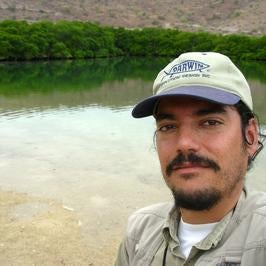
Xavier López-Medellín
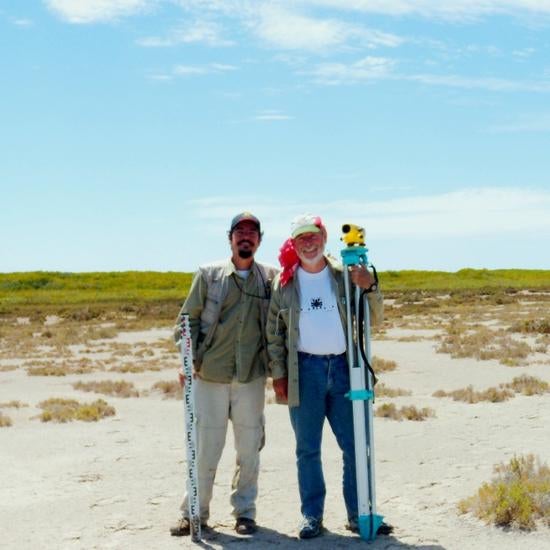
I started my biology studies in Mexico City, at the Universidad Nacional Autónoma de México (UNAM), surveying and analyzing the trade of wild birds in Mexico. After that, I obtained a Masters degree on biological sciences at UNAM with a project that explored the relation between human demography and economic activities with the conservation status of natural resources in Mexico.
Throughout my study years, I realized the importance of integrating different kinds of knowledge and skills to envisage new paradigms that will ensure the conservation and sustainable use of natural resources in Mexico.
I met Exequiel Ezcurra when I moved to Baja California back in 2005. After discussing about my research interests, he encouraged me to get a doctoral degree in UNAM and we started planning a project to evaluate different aspects of the mangroves in the arid northwestern Mexico with the use of different methodologies and disciplines.
The final outcome was a holistic project that led us to develop four different studies: (1) First, we explored how sea-level rise and oceanographic anomalies like El Niño are expanding mangrove surface by pushing them inland as the sea rises with the gradual melting of the polar ice sheets. For this study, we used sea level measurements, GIS, historical images, C14 dating, and lots of field work. (2) We then analyzed the importance of mangroves in producing organic material by performing a meta-analysis on the results of several productivity studies. (3) By performing a historical ecology study, we explored how population growth in the coasts of northwestern Mexico has led to the modification and degradation of coastal environments . (4) Finally, in our last study we used qualitative research methodologies to analyze perceptions from different social sectors related to mangrove use and/or conservation.
I also worked with Dr. Elisabet Wehncke and the San Diego Natural History Museum studying ecological interactions and the conservation of blue fan palm oases in Baja California.
Currently, I am working as a researcher and professor at the University of the State of Morelos (UAEM) in central Mexico.
Visit my webpage at UAEM: www3.uaem.mx/cibyc/xmedellin.html
My full Curriculum Vitae can be found here.
Publications
López-Medellín, X., A. Castillo and E. Ezcurra. 2011. Contrasting perspectives on mangroves in arid Northwestern Mexico: Implications for integrated coastal management. Ocean & Coastal Management 54:318-329.
López-Medellín, X., E. Ezcurra, C. González-Abraham, J. Hak, L. Santiago and J. Sickman. 2011. Oceanographic anomalies and sea-level rise drive mangroves inland in the Pacific coast of Mexico. Journal of Vegetation Science 22(1): 143-151.
Wehncke, E. V., X. López-Medellín and E. Ezcurra. 2009. Blue fan palm distribution and seed removal patterns in three desert oases of northern Baja California, Mexico. Plant Ecology 208:1-20.
Wehncke, E., X. López-Medellín and E. Ezcurra. 2009. Patterns of frugivory, seed dispersal and predation of blue fan palms (Brahea armata) in oases of northern Baja California. Journal of Arid Environments 73:773-783.
López-Medellín, X. and H. Zarza. 2005. Cryptotis magna. In: Ceballos, G. and G. Oliva (Eds.). Los Mamíferos Silvestres de México. México FCE-CONABIO. Pp. 130-131.
López-Medellín and R. A. Medellín. 2005. Trachops cirrhosus. In: Ceballos, G. and G. Oliva (Eds.). Los Mamíferos Silvestres de México. México FCE-CONABIO. Pp. 198-199.
Zarza, H. and X. López-Medellín. 2005. Cryptotis goodwini. In: Ceballos, G. and G. Oliva (Eds.). Los Mamíferos Silvestres de México. México FCE-CONABIO. Pp. 128-129.
López-Medellín, X., and E. E. Iñigo-Elias. 2002. The Passeriformes cage trade in Mexico: a Challenge for Bird Conservation. Paper presented at The Third North American Ornithological Conference. New Orleans, Louisiana, Sept. 24-28, 2002.
